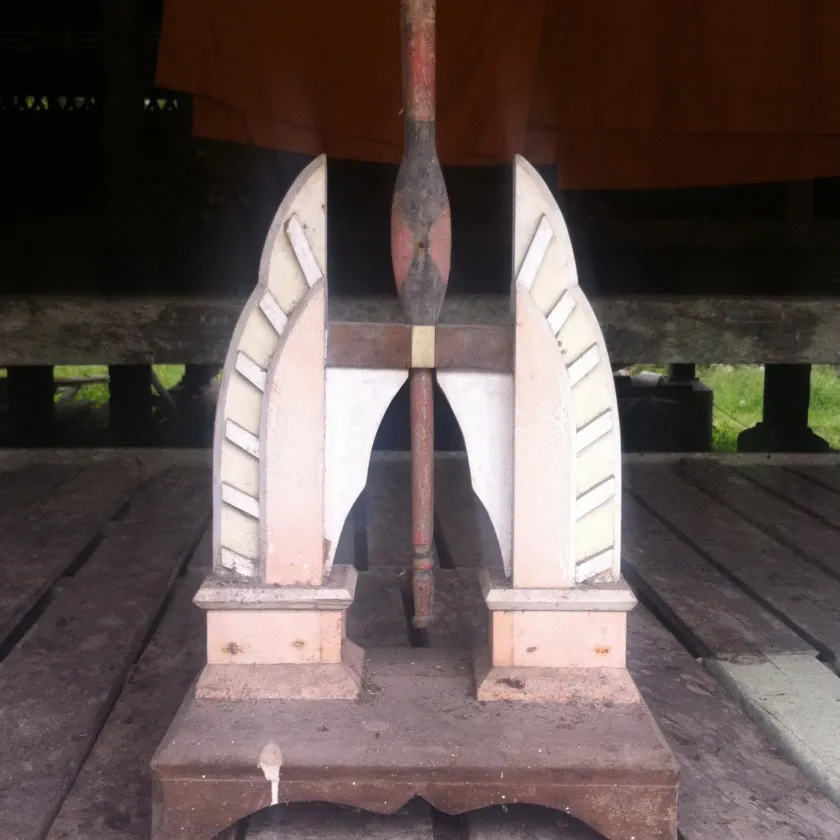Not only were objects with the symbol of the "Constitution Tray" produced by ordinary citizens widely found in various regions after the 1932 revolution, but the monkhood throughout the country also widely adopted this symbol in their designs within the religious sphere. Many places of worship across the country began to design and modify the patterns of their buildings by incorporating the constitution pattern instead of traditional patterns. In addition to serving as a symbol of Thailand's entry into the modern political era, these patterns are also important material evidence confirming the awareness and perception of the changes in governance that deeply penetrated remote local areas and even extended to religious spaces. Examples include the gable of the sermon hall with the constitution tray pattern at Wat Yai Sawang Arom in Nonthaburi Province, the gable of the vihara at Wat Umong Mahathera Chan in Chiang Mai Province, or the backrest of the pulpit at Wat Choeng Tha in Lopburi Province. While most of the objects found still have similar constitution tray patterns as the main image, a carved wooden stand for a talapat (ceremonial fan) discovered at Wat Tha Nang Hom in Hat Yai District, Songkhla Province, has a different appearance of the wings of the Democracy Monument. It can be assumed that this object was not only made to embrace the 1932 revolution but also to celebrate the Democracy Monument that was built afterward.
This ceremonial fan stand is the property of Wat Tha Nang Hom in Hat Yai District, Songkhla Province. It is made of wood and designed in the shape of winged columns of the Democracy Monument. The artisan who created it is unknown, and the period can only be broadly determined as between 1940 and 1947, as the design was directly influenced by the Democracy Monument. Therefore, it could not have been created before June 1940 and was unlikely to have been made after 1947, which marked the end of the People's Party's era. Additionally, the gable of the temple's pavilion features local artisans' stucco work depicting angels holding the Constitution Tray, surrounded by floral patterns. Similarly, the rear gable has a stucco figure of villagers working, along with an inscription stating "2480, the Year of the Ox." The depiction of villagers working aligns with the People's Party's view that the people are the driving force in developing the nation. Considering the year specified in the stucco work on the pavilion's gable (1937), which is likely the year the work was created, and the talapat stand modeled after the winged columns of the Democracy Monument, which was probably made after the completion of the Democracy Monument (1940), these two objects are highly significant evidence reflecting the awakening of personnel in the religious circles at the local level who wished to create "mementos" to reflect democratic ideology, which are rare, and not many remain extant today.
One notable observation from the discovery of objects from the People's Party era within temples across the country that still exists today is that all the objects found were produced in temples of the Maha Nikaya sect. This symbol has not been found in any temples of the Dhammayuttika Nikaya sect (except for the architectural work of Wat Phra Sri Mahathat, Bang Khen, which was built by the People's Party under the concept of merging these two sects together). It can be assumed that the 1932 revolution likely created more awareness and satisfaction among the Maha Nikaya monks than the Dhammayuttika Nikaya monks, especially if we consider the policy of the People's Party that wanted to "merge the sects" together, along with the enactment of the Sangha Act of 1932, which structured the administration of the Sangha in a manner comparable to the secular administration of the country. It allowed for elections and created a process for greater participation of the general monks, etc. This act inevitably challenged the leadership power of the Dhammayuttika Nikaya sect. However, after the People's Party lost power, Field Marshal Sarit Thanarat, the Prime Minister at the time, repealed this act in 1957, reverting back to the original structure that had been in place since the reign of King Rama V. This allowed the Supreme Sangha Council to regain absolute administrative power over the Sangha, and since then, the Supreme Patriarch has always come from the Dhammayuttika Nikaya monks up to the present day.

